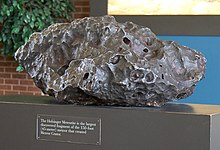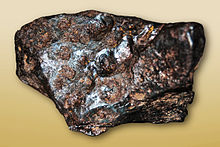| Canyon Diablo | |
|---|---|
 Canyon Diablo iron meteorite fragment (IAB) 2,641 grams Canyon Diablo iron meteorite fragment (IAB) 2,641 grams | |
| Type | Iron |
| Structural classification | Coarse Octahedrite |
| Group | IAB-MG |
| Composition | 7.1% Ni; 0.46% Co; 0.26% P; 1% C; 1% S; 80ppm Ga; 320ppm Ge; 1,9ppm Ir |
| Country | United States |
| Region | Coconino County, Arizona |
| Coordinates | 35°03′N 111°02′W / 35.050°N 111.033°W / 35.050; -111.033 |
| Observed fall | No |
| Fall date | 49000 years ago |
| Found date | 1891 |
| TKW | 30 tonnes |
| Strewn field | Yes |
 Etched slice showing a Widmanstätten pattern Etched slice showing a Widmanstätten pattern | |
The Canyon Diablo meteorite refers to the many fragments of the asteroid that created Meteor Crater (also called Barringer Crater), Arizona, United States. Meteorites have been found around the crater rim, and are named for nearby Canyon Diablo, which lies about three to four miles west of the crater.
History
The impactor fell about 50,000 years ago. Initially known and used by pre-historic Native Americans, Canyon Diablo meteorites have been collected and studied by the scientific community since the 19th century. Meteor Crater, from the late 19th to the early 20th century, was the center of a long dispute over the origin of craters that showed little evidence of volcanism. That debate was largely settled by the early 1930s, thanks to work by Daniel M. Barringer, F.R. Moulton, and Harvey Harlow Nininger.
In 1953, Clair Cameron Patterson measured ratios of the lead isotopes in samples of the meteorite. Through U-Pb radiometric dating, a refined estimate of the age of the Earth was obtained: 4.550 billion years (± 70 million years).
Composition and classification
This meteorite is an iron octahedrite (coarse octahedrite). Minerals reported from the meteorite include:
- Cohenite – iron carbide
- Chromite – iron magnesium chromium oxide
- Daubréelite – iron(II) chromium sulfide
- Diamond and lonsdaleite – carbon
- Graphite – carbon
- Haxonite – iron nickel carbide
- Kamacite iron nickel alloy – the most common component.
- Base metal sulfides
- Schreibersite – iron nickel phosphide
- Taenite – iron nickel alloy
- Troilite – a variety of the iron sulfide mineral pyrrhotite. The troilite in this sample is used as the standard reference for sulfur isotope ratios.
- Moissanite – a variety of silicon carbide, the second hardest natural mineral.
Samples may contain troilite-graphite nodules with metal veins and small diamonds.
Fragments


The biggest fragment ever found is the Holsinger Meteorite, weighing 639 kilograms (1,409 lb), now on display in the Meteor Crater Visitor Center on the rim of the crater. Other famous fragments:
- 485 kilograms (1,069 lb), Canterbury Museum, Christchurch, New Zealand. The largest fragment outside the United States.
- 360 kilograms (790 lb), Muséum national d'Histoire naturelle, Paris, France.
- 283.5 kilograms (625 lb), Archenhold Observatory, Berlin, Germany.
- 242.6 kilograms (535 lb), Lowell Observatory in Flagstaff, Arizona.
- 226,8 kilograms (500 lb), MINES ParisTech Mineralogy Museum, Paris School of Mines, France.
- 225.9 kilograms (498 lb), Academy of Natural Sciences of Drexel University, Philadelphia, Pennsylvania.
- 194 kilograms (427 lb), Beloit College, Beloit, Wisconsin.
- 179 kilograms (395 lb), Griffith Observatory, Los Angeles, California.
- 169 kilograms (373 lb), Van Vleck Observatory, Wesleyan University, Middletown, Connecticut.
- 162 kilograms (357 lb), "Clark Iron," Meteorite Gallery, University of California, Los Angeles.
- 145 kilograms (320 lb), Geology Museum, University of Wisconsin, Madison, Wisconsin.
- 136 kilograms (300 lb), Franklin Institute, Philadelphia.
- 122 kilograms (269 lb), Griffith Observatory, Los Angeles, California. Fragment loaned by the Geology Department of Pomona College.
- 100 kilograms (220 lb), California Academy of Sciences, San Francisco.
- 82 kilograms (181 lb), Trinity University, San Antonio, Texas.
- 54 kilograms (119 lb), Newark Museum, Newark, New Jersey.
- 46 kilograms (101 lb), Branner Library, Stanford University, Stanford, California.
- 28 kilograms (57 lb), Peoria Riverfront Museum, Dome Planetarium, Peoria, Illinois.
- 22 kilograms (49 lb), Basket Meteorite, Meteor Crater Museum, Arizona.
- 19 kilograms (42 lb), Wagner Free Institute of Science, Philadelphia.
- 266 grams (0.6 lb), Laurence Edward Oram, Phoenix, Arizona
- 69.2 grams (0.15 lb), Robert Tullman, St. Petersburg, Florida.
See also
References
- Meteoritical Bulletin Database: Canyon Diablo
- "Spaceguard Foundation UK". Archived from the original on November 17, 2006.
- "Barringer Crater". Oxford Reference. Oxford. Archived from the original on November 17, 2021. Retrieved November 16, 2021.
- Roddy, D. J.; E. M. Shoemaker (1995). "Meteor Crater (Barringer Meteorite Crater), Arizona: summary of impact conditions". Meteoritics. 30 (5): 567. Bibcode:1995Metic..30Q.567R.
- Barringer, D.M. (1906). "Coon Mountain and its Crater." Proceedings of the Academy of Natural Sciences of Philadelphia, 57:861–886. PDF Archived 2016-03-04 at the Wayback Machine
- Moulton, F. R. (August 24, 1929). Report on the Meteor Crater – I. Philadelphia: Barringer Crater Company.
- Moulton, F. R. (November 20, 1929). Report on the Meteor Crater – II. Philadelphia: Barringer Crater Company.
- Crowson, Henry L. (1971). "A method for determining the residual meteoritical mass in the Barringer Meteor Crater". Pure and Applied Geophysics. 85 (1): 38–68. Bibcode:1971PApGe..85...38C. doi:10.1007/bf00875398. S2CID 140725009.
- Artemieva N.; Pierazzo E (2010). "The Canyon Diablo impact event: Projectile motion through the atmosphere". Meteoritics & Planetary Science. 44 (1): 25–42. doi:10.1111/j.1945-5100.2009.tb00715.x.
- Nininger, Harvey Harlow (1956). Arizona's Meteorite Crater. Sedona, Arizona: American Meteorite Laboratory. ISBN 978-0910096027.
- Levy, David (2002). Shoemaker by Levy: The man who made an impact. Princeton: Princeton University Press. pp. 69, 73–75, 81–83. ISBN 9780691113258.
- Patterson, C. (1956). "Age of Meteorites and the Earth". Geochimica et Cosmochimica Acta. 10 (4): 230–237. Bibcode:1956GeCoA..10..230P. doi:10.1016/0016-7037(56)90036-9.
- "Canyon Diablo Meteorite; MET16 on eHive". eHive. Archived from the original on 2021-02-22. Retrieved 2024-05-17.
- "Archenhold Observatory homepage". Archived from the original on 2024-02-22. Retrieved 2024-02-22.
- Henricks, Larry (June 7, 2009). "Meteorite moves to Flag". Arizona Daily Sun. Archived from the original on April 6, 2019. Retrieved May 17, 2024.
- "Adirondack Sky Center Meteoroids".
- "When Worlds Collide: Collaboration and Coincidence in a Mystery from the Skies". December 3, 2019. Archived from the original on October 20, 2021. Retrieved October 15, 2021.
- "UCLA's new Meteorite Museum rocks". Archived from the original on June 8, 2013.
- "CrunchGear » Archive » Meteorite chunk about 300 pounds, 5 billion years old". February 13, 2008. Archived from the original on February 13, 2008. Retrieved June 29, 2021.
{{cite web}}: CS1 maint: bot: original URL status unknown (link) - "Rummager's galactic find turns out to be stolen meteorite". Archived from the original on 2014-04-27. Retrieved 2010-10-04.
- "Long-lost meteorite comes home to Arizona".
External links
| Meteorites and meteoritics | |||||||||||||||||||||||
|---|---|---|---|---|---|---|---|---|---|---|---|---|---|---|---|---|---|---|---|---|---|---|---|
| Meteorite... | |||||||||||||||||||||||
| Classification |
| ||||||||||||||||||||||
| Mineralogy and petrology |
| ||||||||||||||||||||||
| Lists |
| ||||||||||||||||||||||